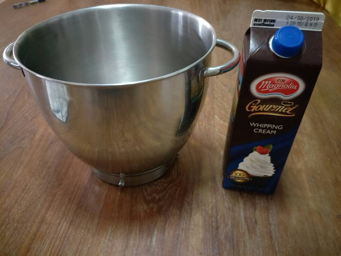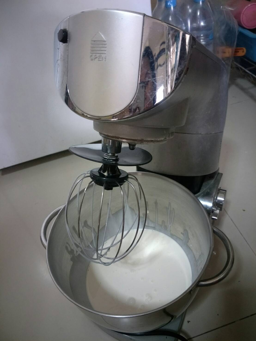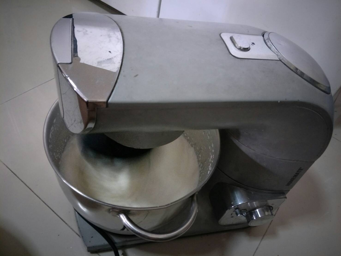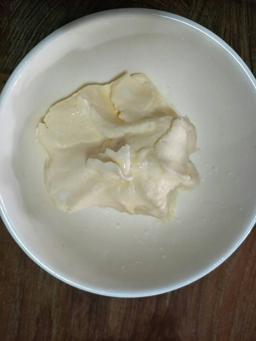
| Created |  Urls Urls |
Favourites | Opened | Upvotes | Comments |
| 5 | 0 | 636 | 0 | 0 |
If people knew how easy it is to make butter, it would be impossible to sell in the store - home made butter is both a LOT better & a LOT cheaper.
(Note that the best store bought butter I know of is Lurpack from Denmark and it is nearly as good as home made, however it comes at a premium price).
Then I was a kid I actually made butter by accident using only a hand whipper while trying to make whipped cream. At that time I saw it as a failue - too much whipping. However, that is exactly how you make butter : whip it a little more and the whipping cream will part into buttermilk and butter.
Index : how to make
Buy 1 liter of whipping cream and prepare a bowl.

Pour all of the whipping cream into the bowl

Start whipping and continue whipping.

Keep whipping until the cream parts.

You can see the buttermilk and the butter.

Garbage the buttermilk (buttermilk does have uses, however I just garbage it) and you are left with the butter.

After massaging the butter a little.

Pack the butter in appropriate sizes and store it in the freezer (there it is good for half a year). Have some of it in the refridgerator there it is good for about a week.
Enjoy.
Then churning cream into butter, the cream splits into butter and buttermilk. In the beginning of making my own butter, I just discarged the buttermilk, however I have later come to learn that buttermilk is quite useful.
Ghee is butter from which water and milk solids have been removed (leaving only the butterfat). Because of the absence of milk solids, ghee have a way higher smoking point than butter, 232C (450F) and 150C (302F) respectively, which makes Ghee better suited for high temperature cooking like roasting and frying. Clarified butter is allegedly also a more stable emulsifier.
To make ghee take some butter and melt it in a pan over medium-low heat until simmering. The water in the butter will slowly evaporate and the milk solids will sink to the bottom as the process creates a sputtering sound. Then the sputtering sounds stops, enough water have evaporated and if the heating is stopped now and the strain startet right away, you have clarified butter. However if you instead of stopping the heating decreases the heating to very low temperatur and keep heating until the color changes from light yellow to deep gold to clear and then strain, you now have ghee - pure butterfat with a nutty flavour.
Ghee and clarified butter are actually 2 slightly different products. Ghee is heated a little longer to caramelizing the milk solids adding a golden color and nutty taste, while clarified butter is stopped heated just before caramelization resulting in a clear colored product. (Note that there is also brown butter, there the milk solids are caramelized even more and typically not strained out of the product, which result in a way nuttier taste and deep brown color. However brown butter is not really a product made for keeping but is instead made ad-hoc from butter then needed. Brown butter is used eg. for oats cookies to create the nutty taste, for sauces and to spoon over pasta and fish. Brown butter is already partly compromised because of the caramelized/burnt milk solids and also does NOT have the important high smoking point and should therefore not be used for high temperature cooking like roasting and frying).
Ghee can be kept up to 3 month at room temperature (unlike butter ghee does not easily go rancid) and up to a year in the fridge. I have not tried to freeze ghee yet (even though I freeze a lot of butter). Ghee is solid in the fridge and liquid at room temperature.
Ingredients :
Directions :
Can keep refrigerated for 2 weeks.